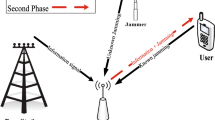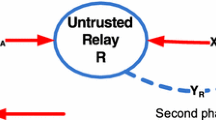Abstract
This paper investigates the physical layer security issue of the coordinated direct and untrusted relay transmissions, considering both uplink and downlink scenarios. To effectively prevent the untrusted relay from eavesdropping on the confidential information it receives, two novel interference-assisted jamming schemes are proposed, where the inter-user interference and the artificial noise are intelligently engineered to degrade the signal reception quality at the untrusted relay, therefore enhancing the physical layer security for the uplink and downlink coordinated transmission, respectively. For each of the two proposed jamming schemes, a lower bound for the ergodic secrecy sum rate (ESSR) is derived in closed form to evaluate the secrecy performance. To obtain more system design insights, we further provide an asymptotic analysis for the ESSR scaling laws over the regimes of the high signal-to-noise ratio and a large number of antennas at the base-station. We carry out computer simulations to confirm the accuracy of the derived theoretical analysis. Our simulation results show that the proposed jamming schemes achieve a similar asymptotic performance limit to the case of using a trusted relay. Moreover, the proposed jamming schemes guarantee perfect security for both uplink and downlink coordinated transmissions, and yield a significant ESSR improvement compared with three other baseline schemes.
Similar content being viewed by others
References
Qi Q, Chen X M, Zhong C J, et al. Physical layer security for massive access in cellular Internet of Things. Sci China Inf Sci, 2020, 63: 121301
Wu Y P, Khisti A, Xiao C S, et al. A survey of physical layer security techniques for 5G wireless networks and challenges ahead. IEEE J Sel Areas Commun, 2018, 36: 679–695
Yue X W, Liu Y W, Yao Y Y, et al. Secure communications in a unified non-orthogonal multiple access framework. IEEE Trans Wirel Commun, 2020, 19: 2163–2178
Lv L, Jiang H, Ding Z G, et al. Secure non-orthogonal multiple access: an interference engineering perspective. IEEE Netw, 2021, 35: 278–285
Li X W, Zhao M L, Liu Y W, et al. Secrecy analysis of ambient backscatter NOMA systems under I/Q imbalance. IEEE Trans Veh Technol, 2020, 69: 12286–12290
Li B, Qi X H, Huang K, et al. Security-reliability tradeoff analysis for cooperative NOMA in cognitive radio networks. IEEE Trans Commun, 2019, 67: 83–96
Zheng T X, Wang H M, Yuan J. Physical-layer security in cache-enabled cooperative small cell networks against randomly distributed eavesdroppers. IEEE Trans Wirel Commun, 2018, 17: 5945–5958
Huang Y Z, Wang J L, Zhong C, et al. Secure transmission in cooperative relaying networks with multiple antennas. IEEE Trans Wirel Commun, 2016, 15: 6843–6856
Lei H J, Yang Z X, Park K H, et al. Secrecy outage analysis for cooperative NOMA systems with relay selection schemes. IEEE Trans Commun, 2019, 67: 6282–6298
Pan G F, Lei H J, Deng Y S, et al. On secrecy performance of MISO SWIPT systems with TAS and imperfect CSI. IEEE Trans Commun, 2016, 64: 3831–3843
Feng Y H, Yan S H, Liu C X, et al. Two-stage relay selection for enhancing physical layer security in non-orthogonal multiple access. IEEE Trans Inform Forensic Secur, 2019, 14: 1670–1683
Deng H, Wang H M, Guo W, et al. Secrecy transmission with a helper: to relay or to Jam. IEEE Trans Inform Forensic Secur, 2015, 10: 293–307
Dong L, Han Z, Petropulu A P, et al. Improving wireless physical layer security via cooperating relays. IEEE Trans Signal Process, 2010, 58: 1875–1888
Cao Y, Zhao N, Pan G F, et al. Secrecy analysis for cooperative NOMA networks with multi-antenna full-duplex relay. IEEE Trans Commun, 2019, 67: 5574–5587
Zhou F H, Chu Z, Sun H J, et al. Artificial noise aided secure cognitive beamforming for cooperative MISO-NOMA using SWIPT. IEEE J Sel Areas Commun, 2018, 36: 918–931
Wang Q, Zhou F H, Hu R Q, et al. Energy efficient robust beamforming and cooperative jamming design for IRS-assisted MISO networks. IEEE Trans Wirel Commun, 2021, 20: 2592–2607
He X, Yener A. Cooperation with an untrusted relay: a secrecy perspective. IEEE Trans Inform Theor, 2010, 56: 3807–3827
Wang L F, Elkashlan M, Huang J, et al. Secure transmission with optimal power allocation in untrusted relay networks. IEEE Wirel Commun Lett, 2014, 3: 289–292
Atapattu S, Ross N, Jing Y D, et al. Source-based jamming for physical-layer security on untrusted full-duplex relay. IEEE Commun Lett, 2019, 23: 842–846
Sun L, Ren P Y, Du Q H, et al. Security-aware relaying scheme for cooperative networks with untrusted relay nodes. IEEE Commun Lett, 2015, 19: 463–466
Li Q Z, Yang L. Artificial noise aided secure precoding for MIMO untrusted two-way relay systems with perfect and imperfect channel state information. IEEE Trans Inform Forensic Secur, 2018, 13: 2628–2638
Lv L, Ni Q, Ding Z G, et al. Cooperative non-orthogonal relaying for security enhancement in untrusted relay networks. In: Proceedings of IEEE International Conference on Communications (ICC), Paris, 2017
Xu H B, Sun L. Encryption over the air: securing two-way untrusted relaying systems through constellation overlapping. IEEE Trans Wirel Commun, 2018, 17: 8268–8282
Xiang Z W, Yang W W, Pan G F, et al. Secure transmission in non-orthogonal multiple access networks with an untrusted relay. IEEE Wirel Commun Lett, 2019, 8: 905–908
Arafa A, Shin W, Vaezi M, et al. Secure relaying in non-orthogonal multiple access: trusted and untrusted scenarios. IEEE Trans Inform Forensic Secur, 2020, 15: 210–222
Lv L, Jiang H, Ding Z G, et al. Secrecy-enhancing design for cooperative downlink and uplink NOMA with an untrusted relay. IEEE Trans Commun, 2020, 68: 1698–1715
Gradshteyn I S, Ryzhik I M. Table of Integrals, Series, Products. San Diego: Academic, 2007
Huang J, Mukherjee A, Swindlehurst A L. Secure communication via an untrusted non-regenerative relay in fading channels. IEEE Trans Signal Process, 2013, 61: 2536–2550
Abramowitz M, Stegun I. Handbook of Mathematical Functions With Formulas, Graphs, and Mathematical Tables. New York: Dover, 1972
Li Y, Li Y Z, Chu X L, et al. Performance analysis of relay selection in cooperative NOMA networks. IEEE Commun Lett, 2019, 23: 760–763
Acknowledgements
This work was supported by National Natural Science Foundation of China (Grant Nos. 61901313, 61941105, 61771366, 61901312, 61971320), National Natural Science Foundation of China for Outstanding Young Scholars (Grant No. 61825104), Natural Science Fundamental Research Plan of Shaanxi Province (Grant No. 2020JQ-306), China Postdoctoral Science Foundation (Grant Nos. BX20190264, 2019M650258), and Open Research Fund of National Mobile Communications Research Laboratory, Southeast University (Grant No. 2020D07).
Author information
Authors and Affiliations
Corresponding author
Rights and permissions
About this article
Cite this article
Lv, L., Li, Z., Ding, H. et al. Secure coordinated direct and untrusted relay transmissions via interference engineering. Sci. China Inf. Sci. 65, 182304 (2022). https://doi.org/10.1007/s11432-021-3259-0
Received:
Revised:
Accepted:
Published:
DOI: https://doi.org/10.1007/s11432-021-3259-0




